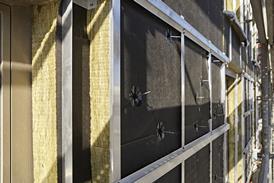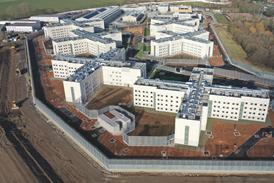The housing market renewal fund, launched in the government's Sustainable Communities Plan earlier this year, is targeted at nine "pathfinder" areas where there are large quantities of homes in low demand. Almost 1 million homes are blighted, according to estimates, and the pathfinder areas cover half of them. The national press has characterised the strategy with the facile headline "bulldoze the North", but the housing renewal programme is not that simple or that Stalinist.
"There are areas that have been forgotten and, in those areas, there is a need for government intervention," says Tom Bloxham, chairman of developer Urban Splash. "It's like the city-centre collapses of 10 years ago." Unpopular housing, much of it Coronation Street-style Victorian terraces unsuitable for modern living, and too small for today's more flexible and ethnically diverse family groupings, could be revamped or demolished and new homes built, along with other facilities and environmental improvements.
The Salford experiment
But the ingredients of the regeneration recipe vary according to region. The pathfinders, driven by the relevant local authority, are charged with responsibility for identifying locations where intervention is necessary and with producing development frameworks for them. This information feeds into a prospectus that is submitted to Office of the Deputy Prime Minister in order to win a share of the £500m.
So far, Manchester–Salford is the only pathfinder that has had its prospectus approved, but it illustrates the possibilities of the project.. Last month, it was awarded £125m by ODPM, and it expects to use that to attract £646m from the private sector. The total budget, taking into account other sources of public funding, may be as high as £1.3bn. No wonder those in the know are talking of housing market renewal as the next big thing. "It is not a five-minute project," says Christine Holgate, pathfinder network organiser with the National Housing Federation. "We're talking about hundreds of projects."
Not all of that money will go into construction, as a substantial sum will have to be set aside to buy sites, many of them individual homes. In central Salford alone, nearly £16m has been set aside for strategic site assembly. That said, the Manchester–Salford pathfinder programme is aiming to clear 1700 redundant and obsolete properties, refurbish and upgrade 13,400 homes, and build 1000 new ones. In Salford's Broughton area, the scheme will bring in housebuilders to build high-value homes. It is also considering "value insurance" to give buyers confidence that their investment will be protected.
It is the job of National Housing Federation's Christine Holgate to ensure that housing associations exploit the opportunities generated by such activity. "The pathfinders will be an opportunity for housing associations to branch out into work they have not been involved in before, such as neighbourhood management and acting as housing advisers to private landlords," she says.
Urban Splash's rethought terrace The pathfinders are also looking to design quality and innovation to help in the regeneration process. In Rochdale, a 1.8 ha site in Wardleworth and Hamer is setting the standard for the region's pathfinder, with poor-quality housing to be replaced by terraced designs by Proctor and Matthews.
"The intention is to drive up design quality," says Dean Aggett, senior project officer with Rochdale Development Agency. "Housing needs to be distinctive to make residents want to stay and attract new people." Aggett does, however, acknowledge that there has been a lengthy consultation process to win the community over to the terraced homes. "Local aspirations are for semi-detached homes," he sighs.
Private housebuilders' reactions to working with such worthy principles has yet to be tested as the site has yet to be sold. It will have about 68 homes, with 70% for the private market and social homes pepperpotted through the scheme. "It is going to be difficult to make developers think differently, but this is the standard we want to reach," says Aggett. "We want to hold on to the creative designs." Max Steinberg, chief executive of East Lancashire's pathfinder, called Elevate, is more optimistic. "We've been contacted by a number of national housebuilders already," he says.
Developer Urban Splash plans to give the terraced houses in its Seedley and Langworthy projects in Salford a radical revamp, instead of tearing them down. The redesign by architect Shed KM will include moving kitchens into a mezzanine in the roofspace, making the first floor into an open plan living area and glazing the rear elevation.
The project is making slow progress. "We have a planning application in, but it will be lengthy because of the time taken to bring through compulsory purchase orders for the homes," says Bloxham. "We're putting a prospectus in place for 15 years," says Elevate's Steinberg. "We anticipate there will be funding to take this forward." As long as it does, there will eventually be a building bonanza.
Following the pathfinders
Birmingham and SandwellThe pathfinder expects to submit its prospectus to Office of the Deputy Prime Minister by the year end. Covering an area of 60,000 homes, it is already carrying out works, including demolition of three tower blocks in West Bromwich.
East Lancashire
Having christened itself “Elevate”, the East Lancashire pathfinder has assembled a high-profile management team with former Housing Corporation boss Max Steinberg as chief executive and former English Partnerships chief David Taylor as chairman. The area encompasses Blackburn, Hyndburn, Burnley, Pendle, Rossendale and Ribble Valley – with a total of 85,000 homes. Elevate will submit its prospectus to ODPM soon.
Hull and East Riding
This pathfinder is in the early stages and is not expected to complete its prospectus until next year. Managed by Carl Bunnage, with chairman Stuart Whyte, it covers 56,000 homes.
Merseyside
Merseyside’s prospectus should be dropping through ODPM’s letterbox imminently. Its territory has 124,000 homes in Liverpool, Sefton and the Wirral. The chief executive is Pauline Davis.
Newcastle and Gateshead
This pathfinder covers 77,474 homes, two-thirds of which are in Newcastle. It is headed by chief executive Jo Boaden and has submitted its prospectus to the ODPM.
North Staffordshire
This pathfinder for Stoke-on-Trent is headed by government adviser and one of the architects of the housing market renewal fund, Brendan Nevin. The prospectus is in preparation.
Oldham and Rochdale
The pathfinder has yet to submit its prospectus, but the Wardleworth and Hamer site has already been masterplanned. The pathfinder is led by Alastair Graham.
South Yorkshire
Covering Sheffield, Barnsley, Rotherham and Doncaster, South Yorkshire is the largest of the pathfinders with 140,000 homes within its remit. The chairman is former ODPM official Mike Gahagan and chief executive is Jeff Goode.
Manchester–Salford
This pathfinder covers Salford as well as east, north and south Manchester. Eammon Boylan heads the Manchester elements of the scheme and Charles Green looks after Salford.
























No comments yet